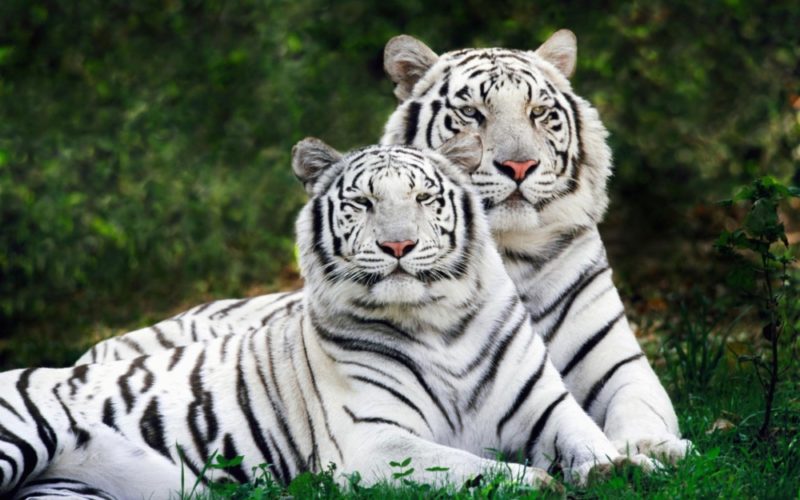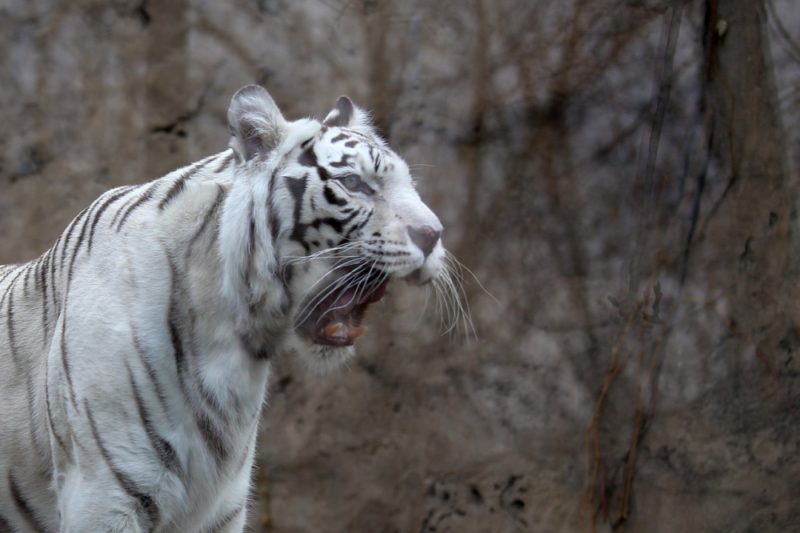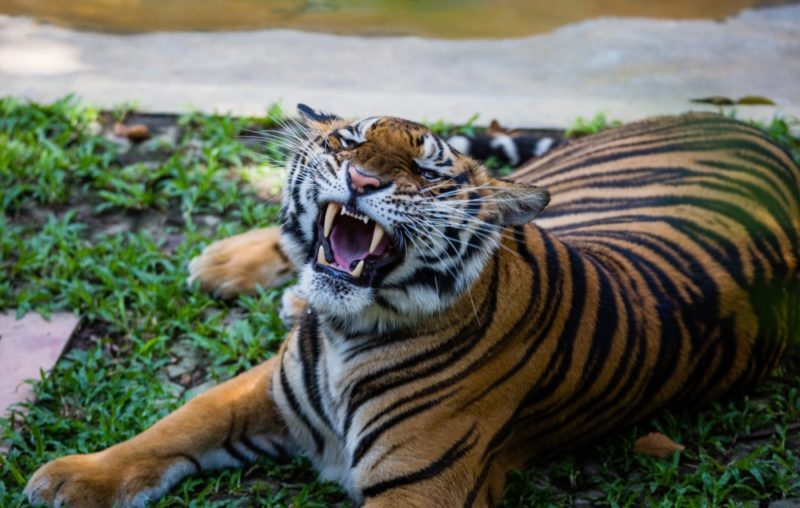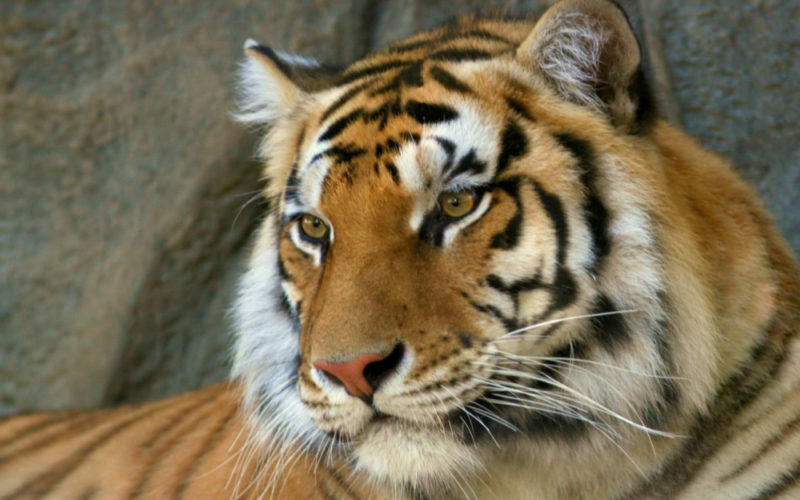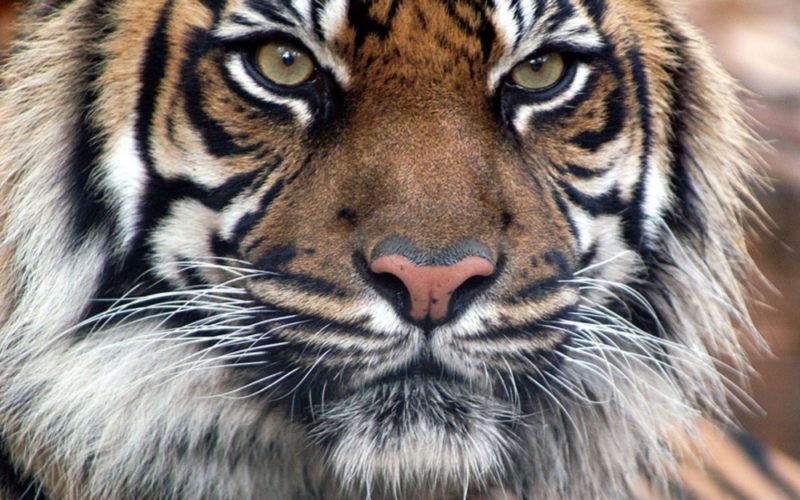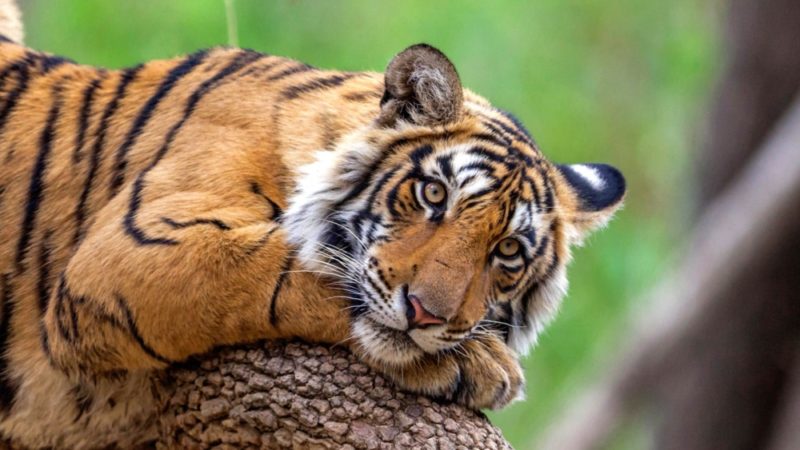Bengal tiger (Panthera tigris bengalensis) is the most numerous subspecies of the tiger. This is a large strong animal, which causes both fear and admiration. In the wild, this predator has a high chance of survival, but under the influence of circumstances the number of representatives of this family is constantly decreasing. In this regard, the Bengal, or as it is also called, the royal tiger is given special attention and honor.
Material Content:
Description of the appearance of the royal tiger
The external characteristics of the Bengal tiger are amazing. He has a large muscular body, the length of which can reach up to 370 cm in males and 310 cm in tigers. But such impressive dimensions are rare, more often animals are about 3 meters in size, including the tail.
- The height of the royal tiger varies from 90 to 110 cm.
- The tail length can sometimes exceed 1 meter, but usually this figure is 85 - 100 cm.
- The weight of adults is, on average, 221 kg. In rare cases, there were tigers weighing more than 3 centners. Females are almost two times smaller than males and grow up to 140 - 150 kg.
This representative of the family has the longest fangs among its relatives. Sometimes they become a ten-centimeter murder weapon. Its claws are no less dangerous. Sharp and elongated, they can cope with almost any prey in seconds. Helps the king tigers to hunt and successful color. Yellow and light orange in the conditions of the natural habitat of animals becomes for them a real camouflage.Animals covered with black or dark brown stripes are easily masked and have the ability to suddenly overtake the victim. Only in some places, namely on the stomach and tail, does the coat have light transitions.
A white Bengal tiger was artificially bred, which became a decoration of zoos. It can be either completely monochromatic or with dark reddish lines. A distinctive feature of the white tiger are also blue eyes.
Features and habitat
The Bengal tiger lives in the mouths of the Ganges, Ravvi, Satlidzh. Few countries can be proud of having this rare feline on their territory.
Today he lives in the following countries:
- Pakistan (140 individuals);
- Iran (24 individuals);
- Bangladesh (200 individuals);
- India (1706 individuals);
- Nepal (155 individuals);
- Bhutan (67 individuals);
- Russia (5 individuals);
- Myanmar
Royal tigers used to be in Afghanistan, but today they are all exterminated.
The habitat suitable for this predator is savannah, tropical jungle, mangrove swamps and rocky areas. You can meet this cat at an altitude of 3000 m above sea level.
Character, lifestyle and longevity
Bengal tigers are not pack animals. They prefer a solitary lifestyle. Each individual occupies a specific area, which can be 30 - 3000 km². Males have a more pronounced territorial instinct, they actively mark the area and protect it. Marks are stools or claw marks on trees. The male can concede a small territory to females, which in turn sometimes allow strangers to hunt on it.
The life expectancy of a tiger under artificially created conditions is approximately 18 - 26 years. In nature, this predator is able to live much less - at best, 15 years.
Such a difference occurs due to the enhanced care in captivity, namely:
- regular nutrition;
- medical care;
- guard against natural enemies.
The king tiger can spend up to 18 hours a day in a sleeping state. Only at night or at dawn does he go out to eat. Natural data allow the predator to see and hear perfectly at night. Tigers are able to swim and climb trees. Having met the prey, they show restraint and do not attack immediately. They pick up a convenient moment and make a throw in one fell swoop. The tiger’s caution forces him to drag the trophy to a secluded place, which, in their opinion, can be distant even half a kilometer.
Bengal tiger diet
The Bengal tiger is a meat-eating animal, like all its relatives belonging to the cat family. Due to their large body size, these predators can eat about 40 kg of meat at a time. Slow digestion allows them not to hunt for up to three weeks. Healthy adults prey on large prey. They are able to defeat many neighbors. Their diet includes wild boars, roe deer, deer, antelopes, goats, buffalos, gaura. But not only artiodactyls become the target of the tiger. Their victims are often elephants, leopards, wolves, foxes, crocodiles.
Weak, wounded, and old royal tigers choose smaller prey.
They find and eat small animals, such as:
- snakes
- frogs;
- Hares
- badgers;
- monkey;
- porcupines;
- birds.
Oddly enough, predators can even eat insects, namely termites. In an unfavorable period, a hungry tiger will not disdain carrion.
There are differences in the diet of females and males of the Bengal tiger. While females are happy to enjoy fish, offal and rabbit, the male half of the family is likely to refuse such food.
Mating season and reproduction of the animal
Bengal tiger puberty occurs at the age of 4 - 5 years. Tigresses are ready to mate earlier, somewhere in 3-4 years. At this time, the female enters the estrous cycle (a favorable period for conception). It lasts from 20 to 80 days, and the stage of sexual susceptibility lasts only 3 to 7 days.At this moment, the male should come to the female’s territory and mate.
After this, the female is left alone. Her pregnancy lasts 14 to 15 weeks. A lioness brings about 2 to 4 cubs into the world, but despite this, the animal population is still declining. Babies after birth are completely helpless and blind. Only the mother is responsible for their upbringing, while the father does not take part in this process. Among the Bengal tiger kittens, which is noteworthy, even twins are found. The lioness’s milk is fed on the tiger cubs for 6–8 weeks, after which it begins to introduce meat feeding to them.
Reaching one year, the royal tiger can begin an independent hunt.
At first he chooses small prey, and with age he targets large artiodactyls, wolves and foxes. At 2 - 3 years old, the animals separate from the mother and lead a separate life completely.
Natural enemies
The habitat of the Bengal tiger is such that all surrounding animals are weaker than it. It is in their power only to one extent or another to harm his health. Even such a strong and formidable predator as a bear is afraid of this representative of the cat family and takes refuge from it in a tree. The tiger, in turn, can wait a long time for the clubfoot on the ground. Sometimes a Bengali even gets a bear out of the den. Both animals can suffer in a fight, but, as a rule, the tiger wins.
A direct competitor to the royal predator is the leopard. Both animals are quite formidable and strong, therefore it is in their interests to maintain neutrality, to less overlap and conflict. Skirmishes, as an exception, occur only in case of lack of food.
The red wolves (dholi), which are quite a lot in India, alone are not able to withstand the tiger, but in a pack they pose a serious threat to the animal.
They have acute intolerance to each other and tensions. A flock is able to recapture its prey from a predator, and even to kill with a large concentration of wolves, causing significant damage.
There is also a hidden enemy of the royal tiger, it is an Indian porcupine. Attacking it, the animal injures its mouth and throat with sharp needles. The predator cannot get them, so sometimes the wounds begin to fester. The tiger is weakening, choosing smaller prey, but in the end it dies anyway.
Interesting facts about the predator
Some events that will go down in the history of its habitat are associated with the Bengal tiger.
Those who are just getting acquainted with this animal should learn interesting facts about it:
- Three states (Bangladesh, India and China) officially recognized the king tiger as a national animal and identified it as their symbol.
- The Latin name of the tiger tigris translates as "arrow". The predator received such a name due to the speed of movement. At a short distance without obstacles, this representative of the cat family is able to reach a speed of 65 km / h.
- Tigers have their own identities, like humans. The imprint of their paws is as unique as the fingerprint of a person.
- At night, tigers have 6 times sharper eyesight than humans.
- Although tigers are ruthless in their prey, they are tolerant within the family. The claims regarding the victim or territory in the vast majority of cases are resolved only by demonstrating superiority, but not by a fight.
- To enrich the diet with fiber, tigers can eat some plants.
- The leap of this predator can reach 10 meters.
Among other things, an interesting cross of tiger colors is often found. This is how the strawberry tiger was bred with an unusual color, which belongs to the Bengal breed, but has a thicker coat, white legs and bright orange stripes.
Red Book and Bengal Tiger
The royal tiger is an animal on the verge of extinction. Unfortunately, the number of these handsome men hardly reaches 2500.
Zoodefenders make every effort to preserve such unique creatures, but their numbers continue to decline, and in Afghanistan Bengal tigers have completely disappeared.
Despite the fact that the Bengal tiger is the national animal of India, poachers continue to kill it for the sake of an expensive beautiful skin. In addition to direct prosecution, a negative factor for the survival of these predators is the elimination of habitats. Left without a mother, cubs are almost doomed to death. Thus, the destruction of one individual can lead to serious consequences.
The king tiger is listed in the Red Book as a species close to vulnerable position (IUСN marking). And the CITES convention recognized this species as endangered. This state of affairs has not changed since the end of the 20th century. Although in the middle of the XIX century in India alone, there were up to 100 thousand representatives of this species.
Now the further fate of such a powerful predator as the Bengal tiger is foggy. Despite all the difficulties of living in the wild, man remains the most terrible enemy of the Bengal tiger.


